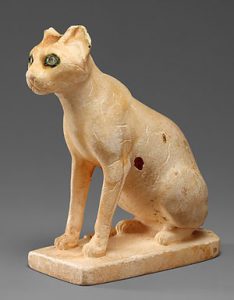
History of cats: Sumerian clay head of a cat (Iraq, ca. 3000-2000 BC)
Evolution of cats
Wildcats first evolved from earlier mammals in Europe during the late Tertiary period, about four million years ago. By around 50,000 years ago, wildcats had spread into West Asia, and by around 40,000 BC, there were cats all across Asia and North Africa. So cats were spreading east across Asia about the same time that people were, but coming from Europe instead of from Africa.
History of dogs
How did mammals evolve?
More about the Tertiary period
History of cats and people
Around 12,000 BC, as people in West Asia began farming, cats started to hang out around human villages, eating people’s garbage, and the mice and rats attracted by the farmers’ stored wheat and barley. By 7500 BC, cats and people liked each other enough that someone on the Mediterranean island of Cyprus was buried with a cat.
The beginning of farming
Stone Age in West Asia

Cat from Old Kingdom Egypt
Cats couldn’t get to an island by themselves, so people must have brought cats there. About 3000 BC, people in China were also beginning to farm, and Chinese cats began to eat rats and garbage in Chinese villages, too. But even though cats lived among people, people didn’t make pets of them. There are almost no house cats in art; cats aren’t mentioned in the Epic of Gilgamesh, either.
What’s the Epic of Gilgamesh?
More about Bronze Age China
Cats in Ancient Egypt

Two men urge a dog and a cat to fight (Kerameikos, Athens, 510 BC)
The first people who admired and worshipped cats were the Old Kingdom Egyptians, beginning around 2100 BC.
Old Kingdom Egypt

Cat (South Italy, ca. 400 BC now in Nicholson Museum, Sidney)
The Egyptian word for cat was “miw” from the sound they made – which was also the Chinese word. Still nobody else took much interest in cats: there aren’t any cats in Homer or Hesiod, or Sophocles, or in early Athenian vase-painting, or in the Hebrew Bible, or in Confucius or Lao Tzu. There’s one image of a cat from classical Greece, but it shows a fight between a cat and a dog, and not a cat as a pet.

Roman cat (House of the Faun, Pompeii, ca. 50 AD)
Cats in Europe and India
Nobody knows why, but people’s feelings about cats changed suddenly around 400 BC. Cats appear in Aristophanes’ plays. They’re carved into Etruscan tombs at Cerveteri. By 300 BC this new attitude towards cats reached India, where cats are mentioned in the Ramayana and the Mahabharata, and the Jataka tales.
What are the Jataka tales?
Who were the Etruscans?

Han Dynasty cat, ca. 100 AD
History of Cats in China
By 100 BC, artists are carving cats in Han Dynasty China – and they’re not the local cats, but West Asian cats that have been brought to China along the Silk Road.
More about the Silk Road
Han Dynasty China
Even the word for cat changes: instead of calling them by their old name, “miw”, now cats are cats – “katta”, “cattus”, “katze”, “qat”, “khatoul” all across Europe, North Africa, and West Asia (though China kept the old “Miw”). (“Puss” probably comes from the sound you make calling a cat.)
Cats, Islam, and Christianity

Cats in the Garden, by Mao Yi (1100s AD, Song Dynasty)
A thousand years later, people’s feelings about cats shifted again. The new religion of Islam, coming from near Egypt, strongly supported cats and rejected dogs as dirty.
More about Islam
Across Spain, North Africa, West Asia, India, Central Asia, and Southeast Asia, cats became even more popular than before. Tabby cats—cats with striped or spotted markings—were especially popular. The name ‘tabby’ comes from the name of an Umayyad prince, Attab, whose name was given to the Attabiy neighborhood in Baghdad. The striped silks made in that neighborhood were called tabby, and striped cats were called tabbies after the silk cloth. In Christian Europe, cats seemed a little heretical, associated with witches, and dogs stayed more popular.
As Europeans invaded the Americas, Africa, and Australia, they brought cats with them, but the division persisted: cats are more popular in Muslim areas, and dogs are more popular in Christian, Hindu, and Buddhist areas, even today.



